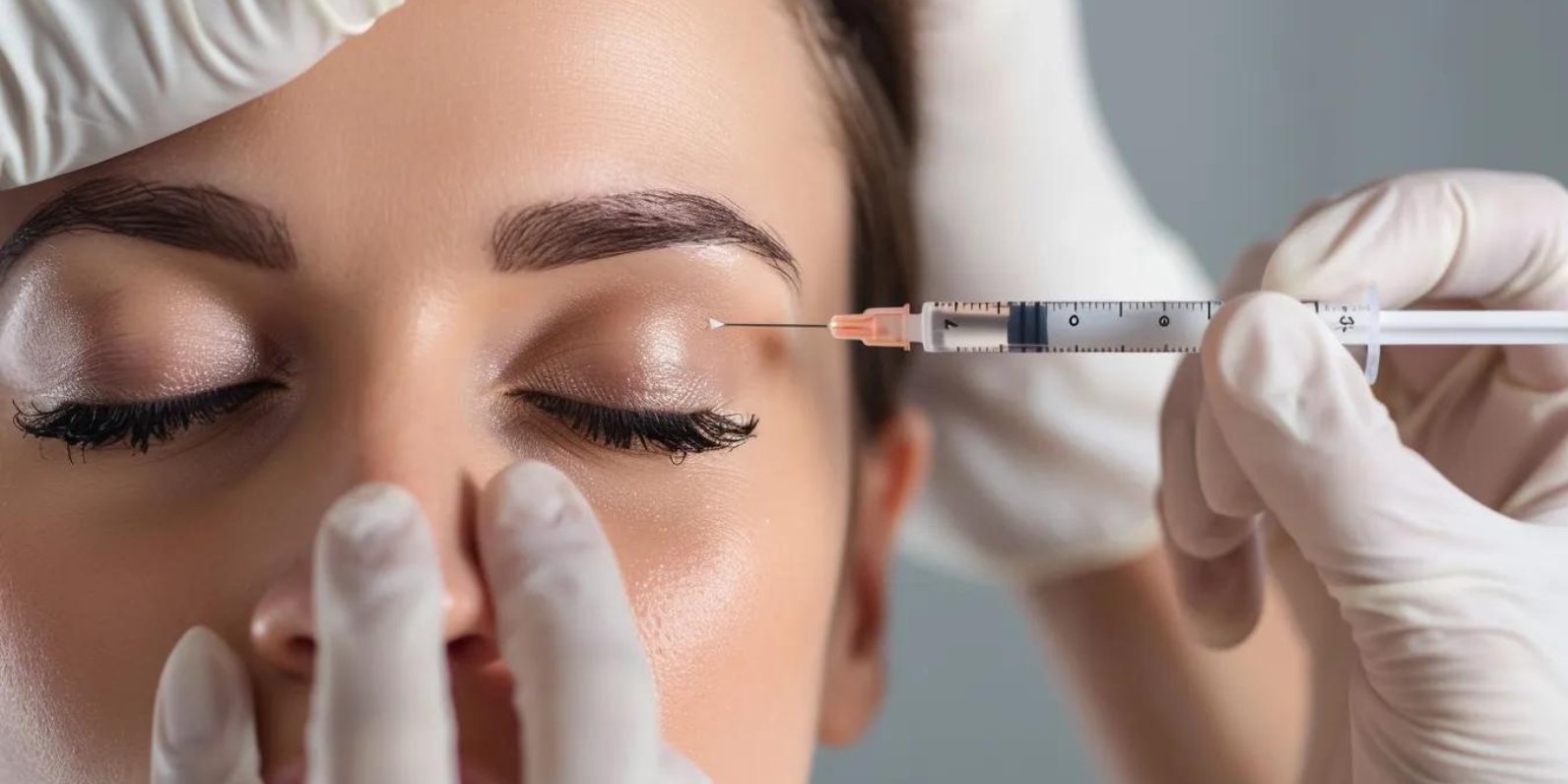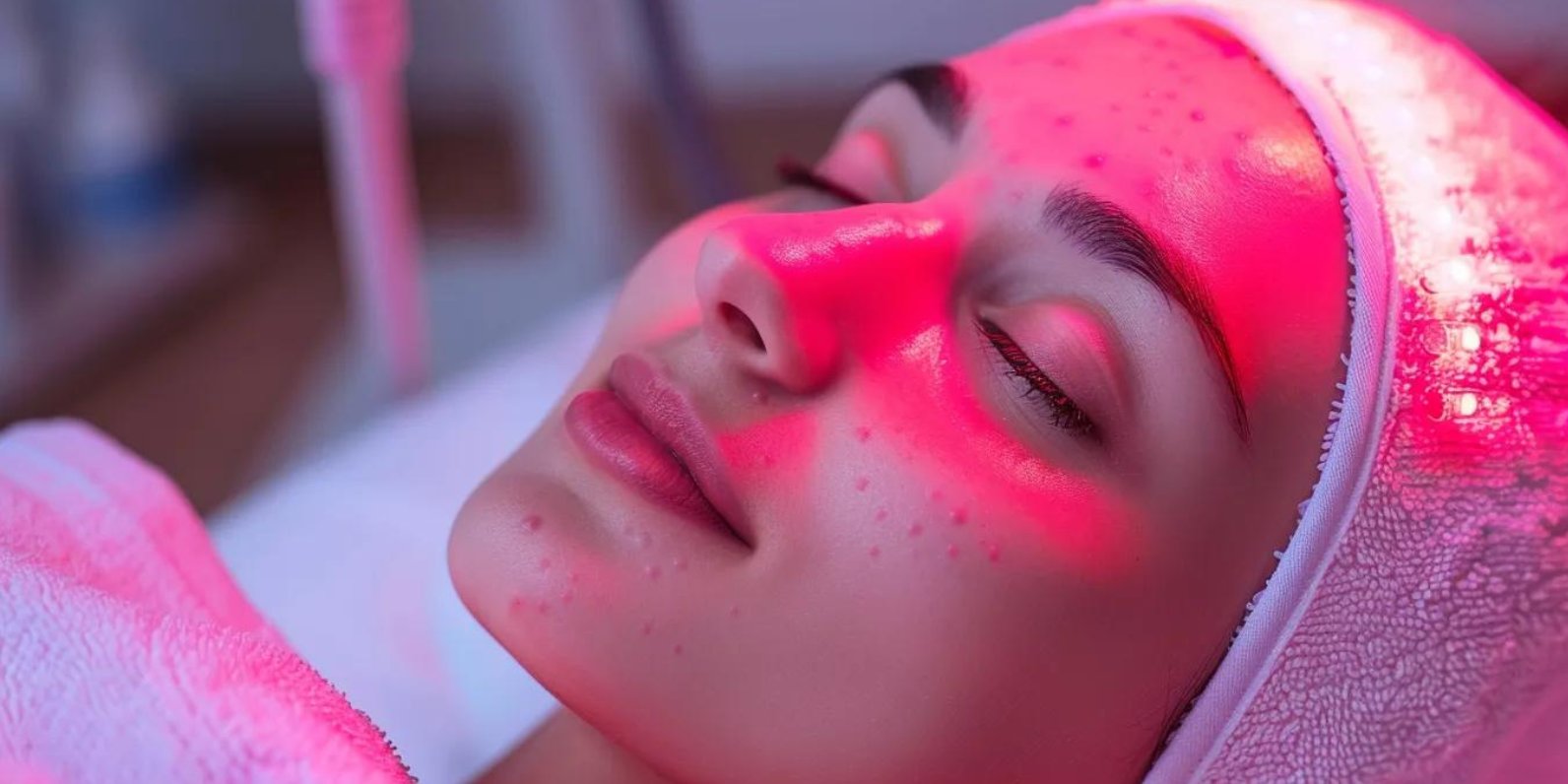You can determine the right facial by understanding your skin type and primary concerns. Oily or acne-prone skin often needs a deep-cleansing or clarifying facial. Dry or sensitive skin benefits from hydrating or soothing facials. If aging or dullness is your concern, opt for collagen-boosting or microcurrent treatments. A licensed esthetician can assess your skin and suggest the best option for visible, lasting results.
What Are The Main Skin Types?
Five basic skin types exist: oily, dry, combination, sensitive, and normal. Most people fit into one category, though skin can change with seasons, age, and hormones.
Oily Skin
Oily skin produces excess sebum, especially in the T-zone including the forehead, nose, and chin. The face appears shiny by midday. Pores look larger and more visible. Blackheads and whiteheads form easily because excess oil mixes with dead skin cells. Research from the American Academy of Dermatology shows people with oily skin often develop fewer wrinkles as they age. The extra oil provides natural moisture that keeps skin plump longer.
Genetics play the biggest role. Hormone fluctuations during puberty, menstruation, pregnancy, or menopause increase oil production. Stress triggers cortisol release, signaling sebaceous glands to produce more oil. Hot, humid climates worsen oily skin.
Dry Skin
Dry skin feels tight, rough, or flaky throughout the day. Sebum production stays insufficient to maintain proper moisture levels. Pores appear small and nearly invisible. Fine lines show more prominently, especially around the eyes and mouth. Cold weather and low humidity worsen dryness by pulling moisture from the skin. Indoor heating during winter creates harsh conditions. Long, hot showers strip natural oils. Aging naturally decreases oil production, making dry skin more common after age 40.
Combination Skin
Combination skin shows oily areas and dry patches on the same face. The T-zone produces excess oil while cheeks feel dry, tight, or normal. This represents one of the most common skin types, affecting approximately 45% of people according to dermatological surveys. Pores appear larger in the T-zone and smaller on the cheeks. Managing combination skin requires a strategic approach using different products on different areas.
Sensitive Skin
Sensitive skin reacts easily to products, weather changes, and stress. Redness, burning, stinging, or itching occurs frequently. The skin may develop rashes, hives, or patches of irritation. Studies published in the Journal of Clinical and Aesthetic Dermatology link sensitive skin to compromised skin barriers. Common triggers include fragrances, alcohol-based products, harsh exfoliants, and extreme temperatures.
Normal Skin
Normal skin maintains balance without excess oil or dryness. Pores stay small to medium in size. Breakouts happen rarely. The skin feels neither tight nor greasy throughout the day. Texture appears smooth and even with minimal visible concerns.
How Do I Test My Skin Type At Home?
The “watch and wait” method reveals your skin type in 30 minutes. Wash your face with a gentle cleanser. Pat dry with a clean towel. Set a timer for 30 minutes and leave your skin completely bare. After 30 minutes, examine your skin in natural light. Tight feeling indicates dry skin. Overall shine means oily skin. Shine in the T-zone with dry cheeks signals combination skin. Comfortable feeling suggests normal skin.
The blotting paper test provides another assessment method. Wash your face and wait one hour. Press blotting papers on different facial areas. Hold each paper up to light. Heavy oil marks indicate oily skin. No oil shows dry skin. Oil only from the T-zone reveals combination skin.
What Skin Concerns Need Facial Treatment?
Active Breakouts And Acne
Breakouts occur when pores clog with sebum, dead skin cells, and bacteria. Whiteheads form when clogged pores close over. Blackheads develop when clogged pores stay open and contents oxidize. Mild acne includes scattered blackheads and occasional pimples. Moderate acne shows more frequent breakouts with inflamed papules and pustules. Severe acne involves large, painful nodules and cysts that often lead to scarring.
Professional acne treatments in Michigan combine deep cleansing, bacteria elimination, and inflammation reduction. Extracting comedones prevents inflammation. Killing bacteria reduces new breakout formation.
Signs Of Aging Skin
Skin aging manifests through multiple visible changes. Fine lines appear first around the eyes and mouth. Deeper wrinkles develop on the forehead and between eyebrows. Skin loses firmness and begins to sag along the jawline and neck. Volume loss creates hollows under the eyes and in cheeks.
Collagen production decreases approximately 1% per year after age 30. Sun exposure accelerates aging through photoaging. UV radiation accounts for up to 80% of visible facial aging according to studies. Professional anti-aging treatments like Morpheus8 for face stimulate new collagen production through controlled micro-injuries combined with radiofrequency energy.
Dryness And Dull Complexion
Dry skin appears flat and tired rather than vibrant. The texture feels rough. Flaking occurs as dead skin cells accumulate. Makeup application looks uneven. Weather strongly influences dryness. Cold air pulls moisture from skin. Indoor heating creates arid environments. Hot showers strip natural protective oils. Harsh cleansers remove too much oil.
Excess Oil And Enlarged Pores
Extra sebum makes skin shiny and greasy. Makeup slides off or oxidizes throughout the day. Large pores appear as visible openings, most noticeable on the nose and cheeks. These dilated pores collect dirt, oil, and dead cells easily. Excess oil production stretches pore openings. Loss of elasticity allows pores to become slack and more visible. Sun damage breaks down collagen around pores.
Dark Spots And Uneven Skin Tone
Dark spots appear as concentrated areas of pigmentation creating uneven skin tone. Post-inflammatory hyperpigmentation develops after acne or inflammation heals. Sun spots result from cumulative UV exposure. Melasma creates larger patches of brown pigmentation on cheeks, forehead, and upper lip. Melanin production increases in response to UV radiation, inflammation, and hormonal signals. Laser skin treatments target and break apart pigment clusters.
What Are The Most Common Facial Treatments?
Classic European Facial
Classic facials deep clean the face through multiple steps. The treatment lasts 60 to 90 minutes. The esthetician begins with thorough cleansing to remove makeup, dirt, and surface oil. Exfoliation follows using mechanical scrubs or enzyme formulas. Steam application opens pores. Extraction removes blackheads and whiteheads. Facial massage stimulates circulation and provides relaxation. Mask application targets specific concerns. Treatment concludes with toner, serum, moisturizer, and sunscreen.
HydraFacial MD Technology
HydraFacial combines cleansing, exfoliation, extraction, and hydration in one device-based treatment. The patented technology uses vortex suction that simultaneously removes debris while infusing serums. The treatment takes 30 to 45 minutes with zero downtime. The device performs painless extraction using vacuum suction. Hydration follows as the device infuses customized serums into freshly cleaned pores. Results appear instantly with skin looking smoother, brighter, and more hydrated.
Chemical Peel Treatments
Chemical peels use acid solutions to remove damaged outer skin layers. Three peel depths exist. Light peels use mild acids at lower concentrations. These treat only the epidermis. Light flaking may occur over 3 to 5 days. Medium peels penetrate through the epidermis into the upper dermis. More significant peeling occurs over 5 to 7 days. Deep peels reach into the lower dermis. Recovery takes 2 to 3 weeks. Chemical peels boost collagen production during healing.
Microneedling And Collagen Induction
Microneedling creates controlled micro-injuries using fine needles that puncture the skin. These wounds trigger the body’s healing response, increasing collagen and elastin production. Research demonstrates microneedling improves acne scars by 51-60% after multiple sessions. Fine lines soften as new collagen fills them. Most protocols recommend 3 to 6 treatments spaced 4 to 6 weeks apart. Microneedling treatments can be combined with radiofrequency energy for enhanced tightening.
LED Light Therapy
LED light therapy uses different wavelengths to treat specific skin concerns. Blue light at wavelengths around 415 nanometers penetrates the epidermis where acne bacteria reside. Research confirms blue light kills these bacteria through photochemical reactions. Red light at 630 to 660 nanometers penetrates deeper into the dermis. This stimulates fibroblast activity, increasing collagen and elastin production. Treatment sessions last 15 to 30 minutes. Initial results require consistent sessions 2 to 3 times weekly for 4 to 8 weeks.
Which Facial Works Best For Oily Skin?
Oily skin needs deep cleaning without excessive sebum removal. HydraFacial excels through powerful yet gentle suction that removes oil, dirt, and dead cells from deep within pores. Sessions every 4 to 6 weeks maintain clear pores. Chemical peels with salicylic acid penetrate oil-filled pores. Salicylic acid dissolves sebum plugs that lead to blackheads. Light peels can be performed monthly. Classic facials with proper extractions remove visible blackheads and whiteheads. Clay masks applied after extraction absorb excess surface oil.
What Facial Helps Dry Skin Most?
Dry skin requires intense moisture infusion and barrier repair. HydraFacial delivers exceptional hydration by infusing serums containing hyaluronic acid, glycerin, and antioxidants deep into pores. The face feels immediately soft and plump after treatment. Oxygen facials provide deep hydration through pressurized oxygen that pushes moisture-rich serums into skin layers. Classic facials designed for dry skin include rich, creamy masks containing shea butter, ceramides, and plant oils. Professional facial rejuvenation services can combine multiple approaches for comprehensive dry skin treatment.
How Should Combination Skin Be Treated?
Combination skin requires zone-specific customization. HydraFacial allows complete customization through interchangeable tips and varied serum selection. The esthetician can use oil-controlling serums with deeper suction on the T-zone while applying hydrating serums with gentler suction on the cheeks. Classic facials work well when the esthetician manually customizes each step. Clay masks may be applied only to the T-zone while hydrating masks go on the cheeks.
What Facials Suit Sensitive Skin?
Sensitive skin needs extremely gentle, fragrance-free treatments that minimize potential triggers. Oxygen facials rank among the gentlest options because no mechanical action touches the skin. The pressurized oxygen feels cool and soothing. HydraFacial can suit sensitive skin when performed with modified pressure and carefully selected serums. LED light therapy using red wavelengths provides anti-inflammatory benefits without any physical contact or chemical exposure.
Which Facial Treats Acne Best?
Acne-prone skin needs deep pore cleansing, bacteria elimination, and inflammation reduction. HydraFacial effectively treats mild to moderate acne through deep pore extraction. Salicylic acid serums penetrate pores to dissolve blockages and kill bacteria. Regular treatments every 3 to 4 weeks keep pores clear.
LED light therapy using blue wavelengths specifically kills acne bacteria through photochemical reactions. Red light combined with blue reduces inflammation and accelerates healing. Weekly sessions for 8 to 12 weeks produce significant improvement.
Chemical peels containing salicylic acid penetrate oil-filled pores to dissolve comedones. Light peels can be performed every 4 weeks. Professional texture and scar treatments can address marks left behind by past breakouts. Never attempt self-extraction. Only trained estheticians should perform extractions using sterile tools.
What Facial Reduces Aging Signs?
Aging skin benefits from collagen stimulation, cellular turnover acceleration, and surface damage removal. Microneedling triggers robust collagen production through controlled micro-injuries. Fibroblasts multiply and synthesize new collagen and elastin. Skin becomes thicker and firmer. Most protocols recommend 3 to 6 sessions spaced 4 to 6 weeks apart. Improvement continues for 6 to 12 months after the final treatment.
Medium-depth chemical peels remove damaged surface layers while stimulating deeper collagen production during healing. Age spots fade as pigmented cells shed. A series of 3 to 4 peels produces optimal improvement. Advanced treatments combine microneedling with radiofrequency energy. Skin tightening treatments using various technologies provide non-surgical lifting.
Injectable neurotoxins relax muscles that create dynamic wrinkles. Dermal fillers restore volume loss in cheeks, temples, and under eyes. Combining injectables with resurfacing treatments creates comprehensive facial rejuvenation.
How Do I Choose A Facial For Specific Goals?
Quick Results Before Events
Events requiring rapid improvement with zero downtime call for specific choices. HydraFacial delivers instant radiance because skin gets deeply cleaned, exfoliated, and hydrated in one session. No redness or peeling occurs. The glow lasts 5 to 7 days. Book 1 to 3 days before weddings, parties, or photo shoots. Oxygen facials provide another quick-result option. Classic facials with brightening masks work well before events. Schedule extraction-focused facials at least one week before important events.
Long-Term Skin Improvement
Lasting skin transformation requires treatments that work at deeper levels. Microneedling creates the most significant long-term collagen production. The full benefits emerge 6 to 12 months after completing a series. Results last 1 to 2 years before maintenance treatments are needed. Medium-depth chemical peels create dramatic changes in skin quality. A series of 3 to 4 peels spaced 6 to 8 weeks apart produces comprehensive transformation. Laser treatments vaporize damaged tissue while creating controlled heat injury that stimulates collagen remodeling.
Maintenance And Prevention
Preventing skin problems proves easier than correcting them after they develop. Monthly HydraFacials maintain clean pores, optimal hydration, and bright complexion. The regular deep cleaning prevents congestion from building up. Quarterly light chemical peels remove accumulated dead cells and stimulate gentle cell turnover. LED light therapy every 4 to 6 weeks maintains collagen production and controls inflammation.
What Should I Expect During My Facial?
Initial Consultation
Every quality facial begins with consultation to assess your skin and discuss concerns. The esthetician will ask about your current skincare routine, products you use, and any reactions. Medical history including medications and health conditions gets reviewed because certain treatments contraindicate specific health issues. Honest disclosure about allergies and sensitivities helps the esthetician avoid triggering ingredients. Skin examination uses bright lighting and magnification to assess your skin type and concerns.
During Your Treatment
Most facials follow a logical sequence designed to prepare skin, treat concerns, and protect afterward. You will lie on a comfortable treatment bed. Cleansing removes makeup, sunscreen, and surface dirt. Exfoliation removes dead skin cells. Steam or warm towel application opens pores. Extractions require skill and proper technique to avoid scarring. Treatment-specific steps vary widely by facial type. Facial massage promotes relaxation and stimulates circulation. Mask application targets your specific needs. Completion includes toner, serum, moisturizer, and sunscreen.
Post-Treatment Guidelines
Your skin may appear slightly pink immediately after treatment. This normal response typically fades within 1 to 3 hours. Some treatments cause more persistent redness lasting 24 to 48 hours.
- Avoid makeup for at least 4 to 6 hours after gentle facials
- Skip active ingredients like retinoids for 24 to 48 hours
Wear sunscreen with SPF 30 or higher every day. The fresh skin is more vulnerable to UV damage. Drink adequate water to support skin hydration. Skip intense workouts for 24 hours after treatments involving extractions or exfoliation.
How Often Should Different Facials Be Performed?
Normal to dry skin benefits from facials every 4 to 6 weeks. This schedule aligns with the natural skin cell turnover cycle of approximately 28 days. Oily or acne-prone skin often needs more frequent facials initially. Starting with treatments every 3 to 4 weeks helps clear existing congestion. Once the skin improves, the frequency can decrease to every 5 to 6 weeks.
Aging skin benefits from combining different treatments at varied frequencies. Intensive treatments like microneedling may be performed in a series of 3 to 6 sessions spaced 4 to 6 weeks apart. Between sessions, monthly HydraFacials maintain skin quality.
Chemical peel frequency depends on peel depth. Light peels can be performed every 2 to 4 weeks for a series, then monthly or every 6 weeks for maintenance. Medium peels require longer intervals of 6 to 8 weeks between treatments.
Book instant-glow facials 1 to 3 days before your event. Schedule treatments that cause peeling 3 to 4 weeks before events so healing completes before the date.
Frequently Asked Questions
Can I Get A Facial If I Have Active Acne?
Yes, you can get a facial with active acne, but choose the right type. HydraFacial and LED light therapy work well for active breakouts because they clean pores and kill bacteria without causing trauma. Avoid aggressive extractions or harsh chemical peels when you have cystic acne or open sores.
How Long Do Facial Results Last?
Facial results last differently based on treatment type. HydraFacial results last 5 to 7 days for the immediate glow. Light chemical peel results last 1 to 2 months. Medium chemical peels maintain improvement for 6 to 12 months. Microneedling results continue improving for 6 to 12 months after your final session and last 1 to 2 years.
What Is The Difference Between A Spa Facial And A Medical Facial?
Medical facials use clinical-grade products and advanced technology not available at day spas. Medical estheticians work under physician supervision and can perform more intensive treatments like chemical peels, microneedling, and laser therapy. Medical facials target specific skin concerns with measurable results. The products contain higher concentrations of active ingredients.
Should I Get A Facial Before Or After A Big Event?
Get a facial 1 to 3 days before a big event for optimal results. HydraFacial and oxygen facials provide instant glow without downtime. Avoid trying new facial types immediately before important occasions. Schedule more intensive treatments like chemical peels or microneedling 3 to 4 weeks before events to allow complete healing.
Can Men Get Facials?
Men absolutely can and should get facials. Male skin tends to be thicker, oilier, and more prone to congestion from shaving. Facials help prevent ingrown hairs, reduce razor burn, control oil, and clear clogged pores. Many men benefit from regular HydraFacials to deep clean pores. Chemical peels help with rough texture and sun damage.
Final Thoughts
Selecting the right facial requires understanding your skin type and identifying specific improvement goals. Oily, congested skin responds to deep-cleansing facials with extraction. Dry, dull skin needs hydrating treatments that restore moisture. Aging skin benefits from collagen-stimulating procedures. Sensitive skin requires gentle, soothing approaches.
HydraFacial provides instant radiance with zero downtime, perfect before events. Microneedling builds long-term collagen improvement over months. Chemical peels remove damaged layers while triggering renewal. LED light therapy targets specific concerns through different wavelengths. Classic facials maintain overall skin health through regular professional cleaning.
Frequency depends on skin type and treatment intensity. Most people benefit from professional facials every 4 to 6 weeks. Combining treatments creates comprehensive rejuvenation. Regular home care between professional sessions maintains and extends results.







